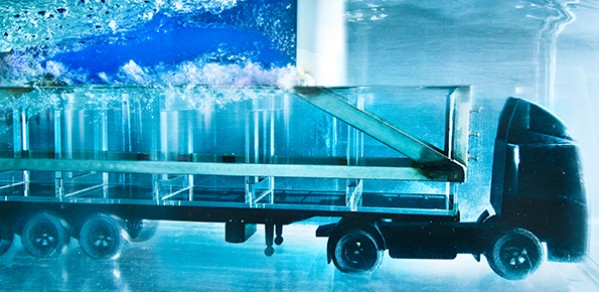
Researchers, working with leading supermarket chain, Waitrose, have developed a more aerodynamic trailer design for articulated vehicles – cutting fuel consumption and pollution by around 7%.
The research not only demonstrates a successful collaboration between academia and industry; it is also important evidence for government which, under the 2008 Climate Change Act, has committed the UK to reducing its emissions by at least 80% by 2050.
Professor David Cebon
In order to accurately gauge how the truck moves through the air, the EPSRC Centre for Sustainable Road Freight (SRF) team at the University of Cambridge used a novel water tank test facility. The team created a video to show this research in action (see below).
The new freight trailer design has led to a 14% reduction in aerodynamic drag and a 3 to 6% reduction in rolling resistance. The modified vehicles consume 7% less fuel, resulting in lower CO2 emissions, and Waitrose has already added 36 of the modified trucks to its fleet.
A vital feature of the SRF’s work is its close links with the freight industry, which has invested £1.4 million in an industrial consortium comprising freight operators such as DHL, John Lewis Partnership, Tesco and Wincanton, as well as vehicle industry partners including Firestone, Goodyear, Haldex and Volvo. These companies help set the research agenda as well as the pace in the adoption of results.
With fuel representing, on average, 45% of operating costs, and with aggressive emission-reduction targets set by government, the road freight industry has substantial incentives to minimise its use of energy.
David Cebon, Director of the EPSRC Centre for Sustainable Road Freight and Professor of Mechanical Engineering, said: “The research not only demonstrates a successful collaboration between academia and industry; it is also important evidence for government which, under the 2008 Climate Change Act, has committed the UK to reducing its emissions by at least 80% by 2050.”
Find out more
Stemming from early EPSRC-supported research at Cambridge by a team of students led by Professor Holger Babinsky, the blueprint for the new trailer design was developed through systematic wind tunnel testing aimed at optimising aerodynamic performance, followed by further testing supported by the Technology Strategy Board (now Innovate UK) and the Office for Low Emission Vehicles (OLEV), as part of a programme to encourage road haulage operators in the UK to buy and test low carbon commercial vehicles.
The research project, which has received further support from Innovate UK and the Office for Low Emissions, was used as a case study in the UK Government’s Clean Growth Strategy, published in October 2017.
This article first appeared on the EPSRC website.

